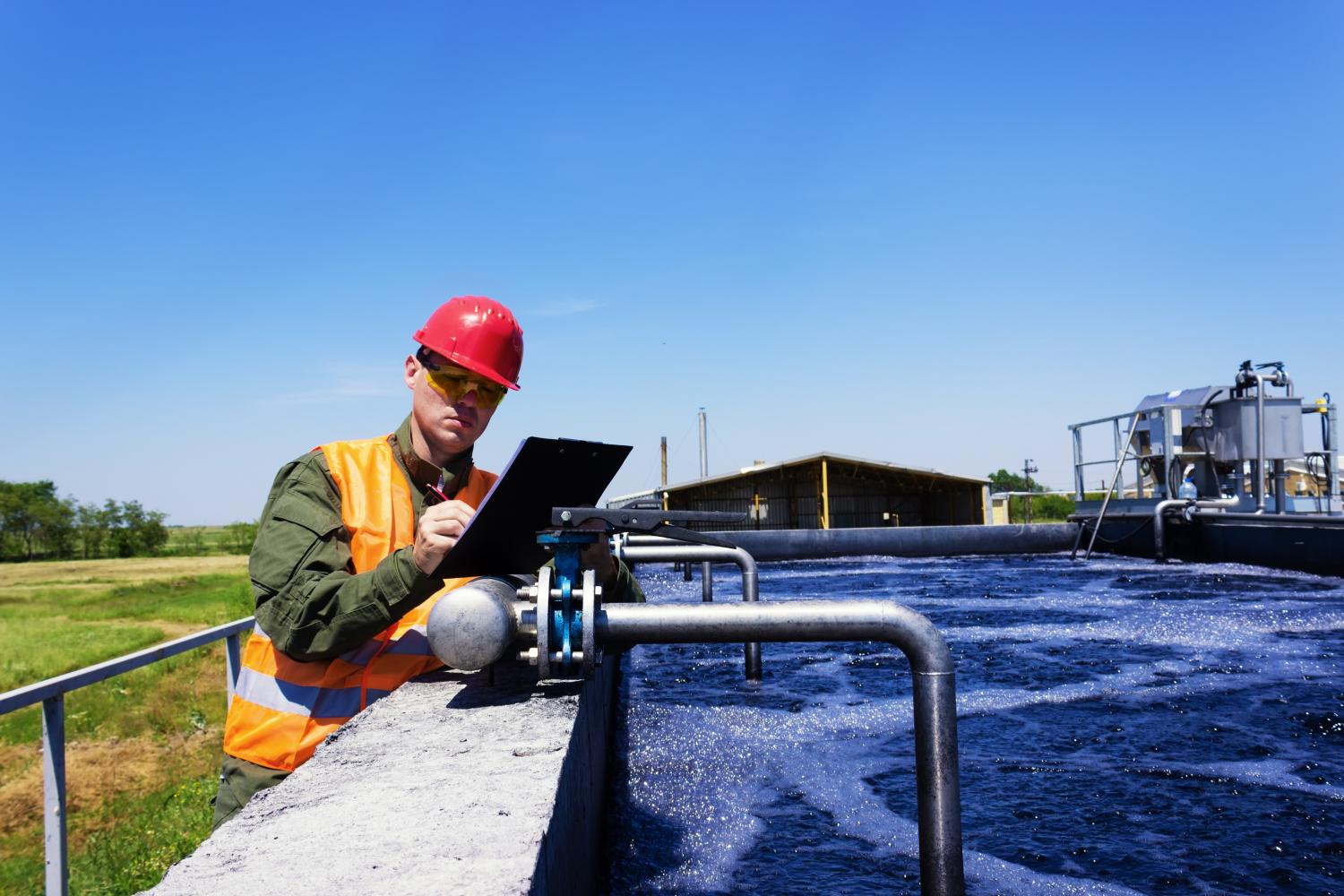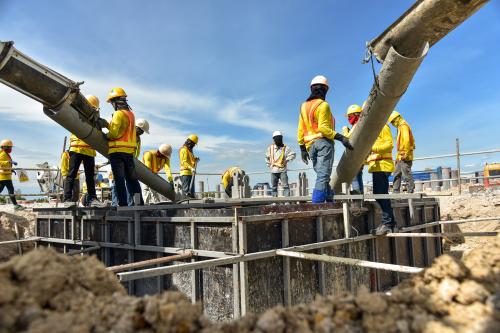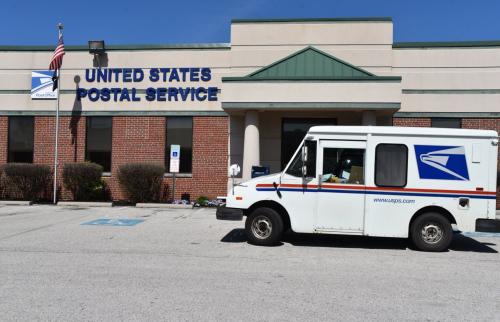This analysis is part of the American Rescue Plan: Strategies for Local Leaders series, a feature of the COVID-19 Metro Recovery Watch.
The pandemic has hit many households hard, but perhaps none more so than those who have struggled to access and afford water. Falling behind on water bills, lower-income households and communities of color have struggled the most, not only dealing with economic pain, but also challenges protecting their health and safety. While many states and localities have prevented water shutoffs and offered to help cover these bills, they lack the economic certainty and fiscal capacity to develop lasting solutions in the months and years to come.
Struggles to pay water bills do not just hurt economically vulnerable residents and communities now. These struggles underscore a challenge to invest in reliable, affordable water infrastructure over time, which can hurt all of us. Our drinking water, wastewater, and stormwater systems provide essential services that require ongoing maintenance and repairs. Investing in pipes, plants, and other facilities is not a choice for state and local leaders; it’s a necessity. And it’s costly, since states and localities are responsible for 95% of the country’s total public spending on water infrastructure annually. Water utilities—the primary owners and operators of all this infrastructure—depend on consistent, predictable revenues from individual households and other ratepayers to cover these costs; yet the past year has been anything but consistent and predictable, resulting in project delays and many other concerns.
These water affordability and investment challenges have been festering for years, and COVID has tipped many people and places over the edge. However, the $1.9 trillion American Rescue Plan, signed in March, offers much needed federal funding for states and localities, including an emphasis on water infrastructure. While $500 million in the ARP will provide assistance to low-income households struggling to afford water—building off previous COVID-19 relief measures—$350 billion comes in the form of flexible state and local aid, which can include water investments that “produce high-quality infrastructure, avert disruptive and costly delays, and promote efficiency…[in addition to supporting] strong employment opportunities for workers.”
Additional federal funding for water offers some stability for households and communities, but state and local leaders need to prioritize and recognize the larger infrastructure opportunity facing them: a need to build off ARP funding to accelerate planning and investment. Receiving flexible federal funding for water infrastructure is rare—let alone getting federal attention—and leaders should not punt on their water needs by assuming that future federal legislation might come through. They need to seize the current ARP opportunity, which can allow them to boost their climate resilience, enhance long-term affordability, and prepare and protect essential workers.
Recognizing the water infrastructure opportunity
Our water infrastructure frequently lacks visibility until disaster strikes, whether it’s Hurricane Harvey overwhelming Houston’s sewers, lead poisonings resulting from Flint’s outdated pipes, or a lack of clean, affordable water during a pandemic. The scale and nuance of water challenges has gained greater attention in recent months, but they have been mounting for decades. A lack of coordinated planning, proactive investment, and other capital and operational pressures—including a changing climate—have added up over time and resulted in an estimated $740 billion in drinking water and wastewater investment needs in the next two decades alone.
While the pandemic helped expose these longstanding challenges, the ARP offers an opportunity: the chance to provide short-term stability while accelerating lasting infrastructure improvements. As federal leaders scaled back direct water funding in the past few decades, many utilities have tried to innovate on their own—pursuing new designs, integrating new technologies, and launching new programs focused on affordability and workforce development. And now, since many utilities are regional authorities (not part of a county or city), they may not be eligible to receive direct ARP funding; they are likely depending on other state and local leaders to give them money, who may not view water as a priority.
State and local leaders need to work closely with their utility partners to maximize the reach of ARP funding, enhance their fiscal and technical capacity, and strive toward meeting several pressing needs:
- Rethinking capital projects to reduce risks and costs. A backlog of infrastructure repairs and upgrades has put many utilities—and local residents—at risk of service interruptions, system failures, and health and safety risks, especially amid a more extreme climate. Rather than simply relying on the same approaches—patching pipes, diverting runoff, and building massive, centralized treatment facilities—additional, flexible federal funding has the potential to accelerate lead pipe removals, expand distributed green infrastructure designs, and embrace new digital data and technologies. From San Diego to Syracuse, utilities have been rethinking the types of projects they pursue to accelerate repairs, use water and energy more sustainably, and boost their ability to adapt to economic and environmental fluctuations. The ARP comes at an advantageous time for many states, too—from California to Texas to Minnesota—as they reassess their capital needs and consider new types of investments.
- Improving water access and affordability. As the need for water investment has increased, so too has the need for higher water rates in many places, resulting in widespread affordability concerns, particularly for lower-income households and communities of color. In some localities, rates have increased by 50% or more since 2010. The COVID-19 pandemic and recession exacerbated these concerns, leading to water shutoffs and disruptions in urban and rural areas However, local customer assistance programs can help lower or cover household bills, and moratoria on water shutoffs—from Detroit to Baltimore—have offered some relief to the most vulnerable households. ARP funding can give utilities the funding and flexibility they need to develop more lasting assistance solutions. For instance, these solutions can build off new state and local affordability initiatives that aim to more precisely measure and direct future support, which can benefit from ongoing federal resources.
- Protecting and preparing essential water workers. Building and maintaining our water systems involve 1.7 million workers across 212 different occupations nationally, including water treatment operators, plumbers, engineers, managers, and more. Vital to protecting our environment and public health, they are also essential workers. While not as visible as essential workers in hospitals, grocery stores, and other sectors of the economy, they share many similar challenges—as they have risked their own health without usually receiving extra pay or protection. ARP funding can help do just that by providing greater hazard pay, extended leave, and other benefits, similar to efforts led in cities such as Atlanta. It can also aid in ongoing recruitment and retention efforts by encouraging local hiring and training, as already evident in cities such as Louisville and Camden that have connected more and different types of workers to water careers with higher pay and growth potential.
Seizing the water infrastructure opportunity
The sizable water challenges—and opportunities—facing the country demand federal, state, and local action. While the ARP offers a baseline of federal funding to jumpstart action, using these funds in ways that address short- and long-term needs at a state and local level depends on better coordination and planning than has traditionally occurred in the water sector. With more than 50,000 water utilities nationally, our water infrastructure is highly localized and fragmented; the easy option for many utilities (assuming they even get ARP funding) is to plan in isolation, dump more money toward the same types of projects, and make hires for immediate job openings. But an infusion of federal support offers the potential to improve capital planning, operational performance, and workforce development as part of a more enduring economic recovery and 21st century national infrastructure vision.
The ARP, after all, is one of many federal proposals addressing infrastructure, and states, localities, and their utility partners need to navigate how to best qualify for and deploy any additional funds. The Coronavirus Aid, Relief, and Economic Security (CARES) Act, signed in March 2020, and the Consolidated Appropriations Act, signed in December 2020, both included water infrastructure-related elements, the most notable of which was $638 million to establish a new Low-Income Household Water Assistance Program (LIHWAP) administered by the Department of Health and Human Services. Meanwhile, the Biden administration’s American Jobs Plan proposes: $56 billion for drinking water, wastewater, and stormwater improvements; $45 billion to replace all lead pipes; and $10 billion to address contamination, among several other measures. Finally, Congress recently advanced the $35 billion Drinking Water and Wastewater Infrastructure Act, including additional project funding and technical assistance.
With so many different federal proposals emerging, state and local leaders may assume utilities—and our water infrastructure systems more broadly—do not need ARP funding. But the ARP can provide an initial pot of funding to give utilities the flexibility and certainty they need to support long-term fiscal stability, environmental sustainability, and economic equity. In much the same way my Brookings colleagues and I recommend for federal leaders, three steps can help state, local, and utility leaders seize this infrastructure opportunity:
- (1) Improve measurement and planning. Water utilities vary widely in their service areas and populations, capital and operational needs, and financial and technical capacities. However, regional collaborations, including more integrated “One Water” planning approaches, can better define goals among multiple local partners and better evaluate progress over time. Combined with improved asset management and lifecycle cost accounting, utilities can also better identify and adapt to evolving system needs. And developing more consistent measures around water affordability, water use, and water investment can inform future-looking policies that promote economic equity and efficiency.
- (2) Modernize existing assets. Armed with more comprehensive plans and detailed measures, utilities can proactively address repairs and upgrades across their entire systems. Replacing leaking pipes, fixing combined sewers, and pinpointing other existing system issues are crucial to providing safe, clean water. Incorporating climate costs and benefits in how we manage water—including projects focused on energy and wastewater reuse—can improve operational efficiencies and support a more resilient built environment. Revising procurement strategies, emphasizing projects with multiple benefits, and considering new management approaches can also attract more funding and revitalize outdated infrastructure.
- (3) Experiment with new designs, technologies, and programs. Utilities cannot just settle for the same types of plans, projects, and outcomes; they need to keep testing new ideas and take new risks. That means looking toward new designs and technologies, including green infrastructure and digital upgrades, but also trying out new financial tools and collaborations, including new types of bonds and community partnerships. Cross-agency coordination and engagement is essential here, too, especially as water utilities partner with educational institutions, labor groups, and other employers to hire and train the next generation of talent.
Looking ahead
The ARP injects timely and necessary federal funding for current water infrastructure needs, but it also sets the stage for more lasting improvements—if state and local leaders recognize water as the short- and long-term priority it is for all of us. Although interest continues to build around the American Jobs Plan and other federal infrastructure proposals, it would be short-sighted to assume that our water needs can simply wait until then and that utilities can manage fine without ARP funding. Additional stability in the short term around affordability programs and protections for essential workers are helpful, but fail to address other mounting needs.
State and local leaders, working alongside utilities, can support a more equitable and resilient recovery by creating new plans and measures, staying ahead of existing repairs and upgrades, and pursuing new designs, technologies, and collaborations. Federal funding from the ARP—or any other proposal—should not simply be a lifeline; it should be enhancing future-looking infrastructure investments across the country and providing greater financial flexibility in a sector that has often lacked such support.
The Brookings Institution is committed to quality, independence, and impact.
We are supported by a diverse array of funders. In line with our values and policies, each Brookings publication represents the sole views of its author(s).








